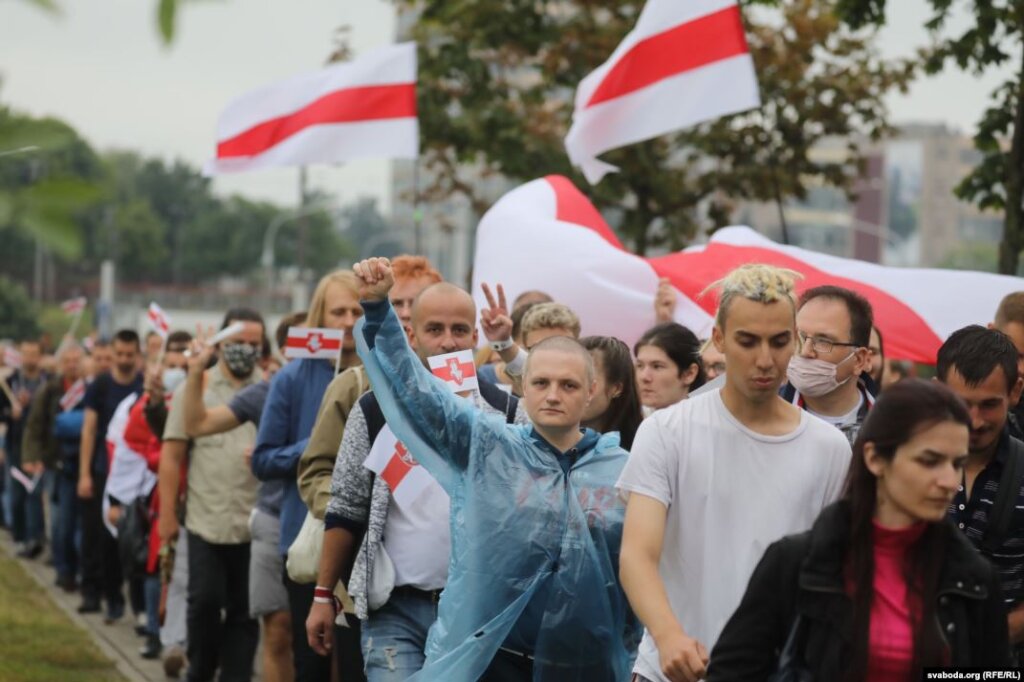This piece originally appeared This piece originally appeared on Transitions Online (TOL) on August 17, 2020.
Peter Rutland is Professor of Government at Wesleyan University.
The demonstrations in Belarus protesting the fraudulent August 9 elections are continuing into their second week, with no signs of abating. August 16 saw dueling meetings of pro- and anti-government supporters – with 30,000 in the former and over 200,000 in the latter, according to the BBC.
Most of the 7,000 or so people initially arrested have been released from prison, and the police have ceded control of many public spaces to the protest movement. They have steered clear of the common tactic of occupying a highly visible public space – such as the Maidan in Kyiv, Tahrr Square in Cairo or Tiananmen Square in Beijing – probably because such a move would just trigger brutal retaliation by the security forces.
But what happens next is anyone’s guess. Recent history suggests that events could go either way. Aleksander Lukashenko may well succeed in clinging to power by sending out the police to beat and arrest protesters. He has plenty of practice, having used these tactics in four previous elections since winning the presidency in 1994.
There are three ways in which Lukashenko could possibly lose power.
First, Lukashenko might lose his nerve, and flee the country – as did Ben Ali in Tunisia in January 2011, or Viktor Yanukovich in Ukraine in February 2014. However, there is no sign that Lukashenko is going to throw in the towel.
Second, Lukashenko might lose the loyalty of his security forces. There have been some reports of police in local communities outside Minsk siding with the protesters. A retired special forces officer, one Colonel Borodach, released a youtube video on August 12 in which he called on the army to refuse Lukashenko’s orders. (The video has been watched over 400,000 times.)
Third, Lukashenko might be forced to step down if he is abandoned by his international allies (ie Russia). Even dictators need friends, who will supply them with the money and weapons they need to stay in power. And Lukashenko has such a friend – Vladimir Putin. The two men spoke by phone on Sunday August 16 and Lukashenko claimed that Putin had offered him “comprehensive security assistance.”
By all accounts Putin and Lukashenko have disliked each other since the day Putin took office. But the strategic location of Belarus, on Russia’s frontier with Europe, means that Putin cannot afford to let Belarus slip out of Russia’s orbit.
The irony is that Lukashenko has been increasingly hostile to Putin in recent years – refusing to accept the annexation of Crimea, for example. In part this was because Lukashenko feared that Putin was planning to fully absorb Belarus into Russia (they have officially been part of a “union state” since 2000). In the run-up to the election Lukashenko was actually trying to whip up anti-Russian sentiment: 33 Russian mercenaries en route to Africa were arrested in Minsk and accused of being part of a plot to overthrow Lukashenko. (All but one of them have now been released.)
To understand where things might go from here it might be useful to put the Belarusian case into its historical context.
The current wave of “People power” revolutions began with the protests that ejected Philippines dictator Ferdinand Marcos back in 1986. Then 1989 saw the fall of the Berlin Wall and the subsequent toppling of communist regimes in East Europe. It seemed that a new international norm had arisen – it was unacceptable for rulers to slaughter peacefully protesting citizens. 2003 saw the beginning of a second wave of “color revolutions” in the post-soviet space that brought down incumbent dictators in Georgia, Ukraine and Kyrgyzstan.
The most recent example was the 2018 “Velvet Revolution” in Armenia which brought down prime minister Serg Sargsian. As in Belarus, a prominent role was played by women who took up the front ranks in demonstrations and dared the police to use violence against them.
Armenia – like Belarus – is a firm ally of Russia, upon whom it relies for security guarantees in its stand-off with Azerbaijan. Opposition leader Nikol Pashinyan made clear that relations with Moscow would not change were he to take power – and as a result Putin maintained a neutral position. Similarly, two color revolutions in Kyrgyzstan, in 2005 and 2010, did not change that country’s geopolitical dependency on Moscow. In 2010 Moscow turned down a specific request from the Kyrgyz provisional government for help in putting down unrest.
Due to its isolated location in the heart of Eurasia Kyrgyzstan has little choice but to cling to Moscow (or be absorbed by China). In contrast it is easy to imagine Belarus following Lithuania and Ukraine in turning towards the West – once Lukashenko is out of the picture.
Of course, not all people-power revolutions were successful. The 2006 “Denim Revolution” failed in Belarus, as did the Saffron Revolution in Myanmar in 2007 and the Green Revolution in Iran in 2009. (Though free elections did finally arrive in Myanmar in 2015). The Arab Spring was the greatest disappointment for advocates of peaceful change. Tunisia aside, none of the 2011 protests resulted in a democratic regime. Although Egyptians toppled dictator Hosni Mubarak in 2011, he was replaced in 2013 by a military regime that has been even more brutal in its determination to crush opposition.
Based on a study of 323 popular movements over the past century, Harvard professor Erica Chenoweth found that 51 percent of peaceful movements were successful 1900-2015, but the success rate has fallen to 30 percent since 2000. She nevertheless affirms that a peaceful movement is “guaranteed” to win if it manages to mobilize 3.5 percent of the total population in a sustained campaign of peaceful resistance (such as boycotts or street protests).
Time will tell whether the Minsk protests have reached that magical tipping point. The Belarusian protests – which have started to include a few strikes – have been overwhelmingly spontaneous, and it is not clear that the opposition has a cohesive organizational underground capable of coordinating a sustained campaign of resistance. But whatever happens on the streets of Belarus, the final outcome may well depend on the decisions of a man sitting 700 kilometers away from Minsk – in the Moscow Kremlin.



